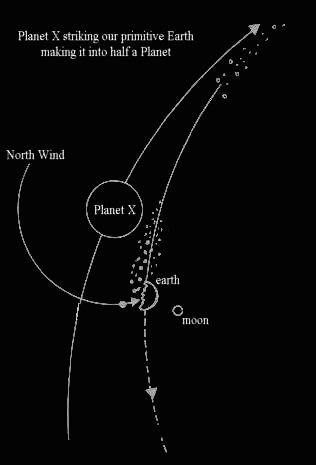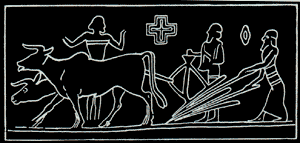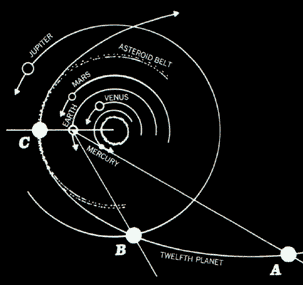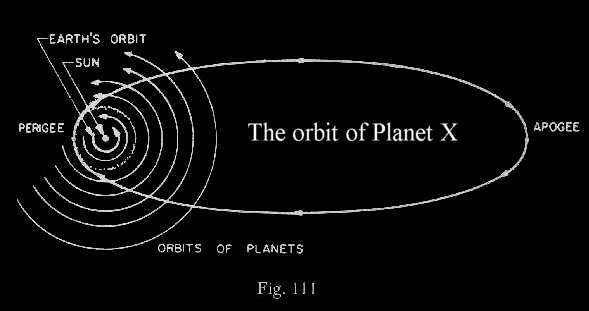
"Far beyond the solar system's nine known
planets, a body as massive as Mars may once have been part of our
planetary system -- and it might still be there;”
The lead
paragraph in a science-fiction script?
The lead paragraph from an article by Zecharia Sitchin about Nibiru?
No. It is
the lead paragraph in a report in Science News of April 7, 2001
headlined "A Comet’s Odd Orbit Hints At Hidden Planet.”
The article
reports the conclusions of an international team of astronomers who
have studied an unusual comet discovered last year, designated 2000
CR/105. It follows a vast elliptical orbit around our Sun – an orbit
that takes it way out to some 4.5 billion kilometers from the Sun, and
brings it back at its closest to the Sun to the vicinity of Neptune;
it is an orbit whose period “takes roughly 3,300 years” (according to
Sky&Telescope News of April 5, 2001).
“Such an
oblong orbit is usually a sign that an object has come under the
gravitational influence of a massive body," wrote R. Cowen in
Science News. Was this the gravitational pull of Neptune? In a
study to be published in the Journal Icarus, the team of
astronomers (led by Brett Gladman of the Observatoire de la Côte
d'Azur in Nice, France), after analyzing all the possibilities, does
not think so. An alternative solution, they say, is that “the
comet's orbit could be the handiwork of an as-yet unseen planet”
-- as massive as Mars -- "that would have to lie some 200 AU from the
Sun," in the so-called Kuiper Belt of cometary and other planetary
debris. This would also explain "why many members of the Belt have
orbits that angle away from the plane in which the nine known planets
orbit the Sun."
“Undoubtedly,
something massive knocked the hell out of the Belt," Harold F. Levison
of the Southwest Research institute in Boulder, Colorado, told the
magazine. “The question is whether it is still there now."
“Comet’s Course Hints at Mystery Planet,”
was how the journal Science headlined the discovery news in
its issue of 6 April 2001. The special report, written by the Dutch
astronomer Govert Schilling, summed up the findings in the following
lead paragraph:
"A Supercomet following an unexpectedly
far-flung path around the sun suggests that an unidentified planet
once lurked in the outermost reaches of the solar system, an
international team of astronomers reports. What's more, the
mysterious object may still be there."
Now, As the Sumerians Said…
Readers of my
books may well join me now in saying: So what else is new?
Ever since
the publication of my first book (The 12th Planet) in 1976 I
have asserted that Sumerian and other ancient Near Eastern texts and
depictions showed familiarity with a complete Solar System that
included, beside the Sun and the Moon, ten (not nine) planets -- the
tenth planet (or twelfth member of the Solar System) having a vast
elliptical orbit that lasts 3,600 years. Its Sumerian name was Nibiru.
I
have-suggested that Sumerian/Akkadian texts such as Enuma Elish (also
called the Babylonian Epic of Creation) were not mythological tales,
but records of sophisticated advanced knowledge. Establishment
scientists and scholars (see a previous article,
The Case of the Misplaced Teapot, as an example) resist
such an inevitable conclusion because it requires the acceptance of
the ancient claim that Earth had been visited by Extraterrestrials,
the ANUNNAKI ("Those Who From Heaven to Earth Came") of Sumerian lore.
According to
the ancient texts as interpreted by me, Nibiru was a planet ejected
from some other planetary system in outer space that was captured into
our Solar System as it passed near Neptune. It became involved in a
collision with a pre-existing planet where the debris of the Asteroid
Belt are now. As a result of that collision, some 4 billion years
ago, the Earth and the Moon came to be where they are now.
And, what do
you know? In an article titled Neptune Attacks! In the 7 April
2001 issue of the magazine New Scientist, Ivan Semeniak wrote
thus:
“There is new evidence that a sudden barrage of
deadly debris crashed against the Earth and the Moon 3.9 billion years
ago… What triggered this onslaught? Something in the structure of the
Solar System must have changed.”
The
“something,” I am more certain than ever, was Nibiru.
To illustrate some of the amazing knowledge the Sumerians possessed
6,000 years ago, I will use a reference to something that to this day
is still being taught in our high schools and colleges. When the Earth
was much older, we can determine the land mass was a once a clumped
together mass at one point in time. But due to the process known as
"Continental Drift" the land clump was slowly pulled apart to where
the current land masses are today. We can see clear proof that the
continents were all once connected by simply looking at a map of the
Earth and seeing how the pieces fit. That would only mean that at one
time, Earth was basically half a planet. If you were to syphon all the
water off of Earth's surface, you would see a large gapping hole where
the ocean has filled in this tremendous missing part of the Earth.
Where did it go? Why is Earth only half a planet? The diagrams shown
here are descriptions from the Sumerians explaining how our Earth came
to be... They state that PLANET X, (Nibiru) as they called it,
collided with our primitive Earth in the past. Creating the asteroid
belt and forever becoming another member of our solar system in a
comet like 3,600 year orbit around the sun.
"PANGEA"
EXPLAINED
BY
THE
SUMERIANS
6,000 YEARS AGO

In February, 1971, the
United States launched Pioneer 10. Pioneer 10 scientists attached to
it an engraved aluminium plaque. It attempts to tell whoever might
find the plaque that Mankind is male and female, etc., and that
(Pioneer 10) is from the 3rd planet of this Sun. Our astronomy is
geared to the notion that Earth is the 3rd planet, which indeed it
is if one begins the count from the centre of our system, the Sun.
But to someone nearing our solar system from the outside, the 1st
planet to be encountered would be Pluto, the 2nd Neptune, the 3rd
Uranus, the 4th Saturn, the 5th Jupiter, the 6th Mars .. and the
Earth would be 7th.
The (12th) Planet's
periodic appearance and disappearance from Earth's view confirms the
assumption of its permanence in solar orbit. In this it acts like
many comets. If so, why are our astronomers not aware of the
existence of this planet? The fact is that even an orbit half as
long as the lower figure for (the comet) Kohoutek, (every 7,500
years), would take the 12th Planet about 6 times farther away from
us than Pluto - a distance at which such a planet would not be
visible from Earth. In fact, the known planets beyond Saturn were
first discovered not visually but mathematically.
| Mesopotamian texts exalt
the planet's radiance and suggested that it
 The
Mesopotamian texts spoke of the planet's periodic appearance as
an anticipated, predictable, and observable event. The nearing
planet, however, was expected to cause rains and flooding, as
its strong gravitational effects have been known to do. Like the
Mesopotamian savants, the Hebrew prophets considered the time of
the planet's approaching Earth and becoming visible to Mankind
as ushering in a new era. The
Mesopotamian texts spoke of the planet's periodic appearance as
an anticipated, predictable, and observable event. The nearing
planet, however, was expected to cause rains and flooding, as
its strong gravitational effects have been known to do. Like the
Mesopotamian savants, the Hebrew prophets considered the time of
the planet's approaching Earth and becoming visible to Mankind
as ushering in a new era. |
 Many
of the Cylinder seals describe the movements of the planet and
the three crucial points at which its appearance can be observed
and charted from earth. The first opportunity to observe the
12th planet as its orbit brings it back to the Earth's vicinity
, then, was when it aligned with Mercury (Point A) - by our
calculations, at an angle of 30 degrees to the imaginary
celestial axis of Sun-Earth-perigee. Coming closer to the Earth
and thus appearing to "rise" farther in the Earth's skies
(another 30 degrees), the planet crossed the orbit of Jupiter at
(Point B). Finally arriving at the place where Planet X
originally Hit the primitive Earth (Point C). Many
of the Cylinder seals describe the movements of the planet and
the three crucial points at which its appearance can be observed
and charted from earth. The first opportunity to observe the
12th planet as its orbit brings it back to the Earth's vicinity
, then, was when it aligned with Mercury (Point A) - by our
calculations, at an angle of 30 degrees to the imaginary
celestial axis of Sun-Earth-perigee. Coming closer to the Earth
and thus appearing to "rise" farther in the Earth's skies
(another 30 degrees), the planet crossed the orbit of Jupiter at
(Point B). Finally arriving at the place where Planet X
originally Hit the primitive Earth (Point C).
The actual expectations for the return of the Kingdom of
Heaven, was thus based on the actual experiences of Earth's
people: their witnessing the periodic return of the 12th
planet.
The planet's periodic appearance and disappearance from
Earth's view confirms the assumptions of its permanence in the
solar orbit. It this it acts like many comets. |
| The Mesopotamian and biblical sources present
strong evidence that the orbital period of the 12th Planet is
3,600 years. The number 3,600 was written in Sumerian as a large
circle. The epithet for the planet, shar, also meant "a perfect
circle" or "a completed cycle". It also meant the number 3,600.
The identity of the three terms - planet/orbit/3,600 - could not
be a mere coincidence. The reign periods (a Sumerian text) gives
are also perfect multiples of the 3,600 year shar. The
conclusion that suggests itself is that these shar's of
rulership were related to the orbital period shar, 3,600 years.

All the people of the ancient world considered the periodic
nearing of the 12th Planet as a sign of great upheavals, great
changes, new eras. The Mesopotamian texts spoke of the planet's
periodic appearance as an anticipated, predictable, and
observable event. "The great planet, at
his appearance dark red." The day itself was described by
the Old Testament as a time of rains, inundation's, and
earthquakes.
If we think of the biblical passages as referring, like their
Mesopotamian counterparts, to the passage in Earth's vicinity of
a large planet with a strong gravitational pull, the words of
Isaiah can be plainly understood. "From a far away land they
came, from the end-point of Heaven do the Lord and his weapons
of wrath come to destroy the whole Earth. Therefore will I
agitate the Heaven and Earth shall be shaken out of its place.
When the Lord of Hosts shall be crossing, the day of his burning
wrath." |
Who Will Determine Your Need
To Know About Planet X (Nibiru)?
YOWUSA.COM, February 18, 2002
Len Bucuvalas
 Nibiru
is a Planet X-class Kupier Belt Object (XKBO) that allegedly is on
an elliptical orbit between our own Sun and a dwarf star that may be
located 18 times the distance from our Sun to Pluto, outside of
Pluto's orbit - an orbit that takes approximately 3600 years to
complete. According to Zacharia Sitchin, the last Earth flyby was
during the Biblical Exodus from Egypt, and it, or some other XKBO
could fly past Earth in 2003 and may cause what some scholars and
scientists feel could become a human catastrophe -- on a Biblical
scale!
Nibiru
is a Planet X-class Kupier Belt Object (XKBO) that allegedly is on
an elliptical orbit between our own Sun and a dwarf star that may be
located 18 times the distance from our Sun to Pluto, outside of
Pluto's orbit - an orbit that takes approximately 3600 years to
complete. According to Zacharia Sitchin, the last Earth flyby was
during the Biblical Exodus from Egypt, and it, or some other XKBO
could fly past Earth in 2003 and may cause what some scholars and
scientists feel could become a human catastrophe -- on a Biblical
scale!
Reuters news service wire, September 13,2000
A group of scientists in Russia in year 2000 held several
meetings to discuss the inbound planet discovered from one of
their largest observatories. This led to the infamous 2003
Problem.
The top government officials called for a commission to study
the problem, which was said to expect to cause “A string of
calamities” &”‘A massive population shrinkage."
They openly wondered whether Russia would still even exist as a
country afterwards...
While many American scientists scoff at Sitchin's work, prominent
Russian scientists (in consultation with their government), along
with several independent researchers around the globe, are deeply
concerned that an XKBO could fly past the Earth in 2003 as his work
suggests.
Such a flyby could result in a terrestrial catastrophe that could
very well place mankind in the cross hairs of a major kill off. Can
we afford to scoff at this threat any longer?
Are there any potential effects of its passing?
|
|
|
Planet X-class Kuiper
Belt Object (XKBO): A Kuiper Belt Object in a long
period orbit around our sun, with sufficient mass to trigger
life-threatening global Earth changes as the result of a
flyby event.
Marshall Masters,
YOWUSA.COM
|
|
It is felt that an XKBO know as Nibiru (and also known as "Marduk")
will pass close by our planet in June of 2003. At the moment of it’s
passing it is possible that the Earth may be overtaken by its
gravitational influence, being a much larger planetary body.
Sometimes referred to as the red comet or red star in some
ancient texts, the effects of its passage may range far and wide
according to current opinion.
- The Earth may stop rotating completely for 3 days.
- Electrical/magnetic storms may occur of an intensity that
could cause lasting damage to our global infrastructure.
- As the Earth passes through tail of Nibiru’s passage, dust and
debris may rain down upon our planet compromising our ability to
supply food, and most importantly, water.
Nibiru is reported to be four times larger, and twenty three
times more dense than the Earth. The Bible states (defining it as
Wormwood in The Book of Revelations) that when it passed, its
magnetic and gravitational effects upon the Earth’s molten iron core
caused increased earthquakes/ volcanic eruptions, and other
phenomena.
I have noticed over the last ten years, as I am sure the readers
of this site also have noticed, the drastic change in our present
day weather patterns, increased earthquake/ volcanic activity,
reports of the gradual slowing of the Earth's rotation and
geomagnetic planetary field deviations, and other anomalies. All of
which are allegedly due to the energy being released by our planet
in response to the gravitational field that is preceding Nibiru.
Has it been here before?
The Dallas Morning News published an article, written by Tom
Siegfried, Science Editor, in the Science Section on February 5th,
2001, titled, “SCIENCE COULD HELP SOCIETIES WEATHER RUINOUS
CLIMATE CHANGE.” The article went on to define certain planetary
events that occurred in our far-flung past. Some have placed the
dates of these events at: 12,387 BC, 8787 BC, 5187 BC, and1587 BC.
The myths and legends of our society are replete with accounts of
gods and their abodes, which strangely correlate to the passage of
Nibiru.
Nordic Legend - Nordic mythology identifies the
Midgard serpent as the destroyer of Earth come to herald in the age
of Ragnarok. Scholars of mythology have postulated that the Midgard
serpent is an allegorical depiction of a comet or planetary body
that whose proximity to Earth disturbs the oceans.
Nordic mythology goes on to state:
The ship that is called Naglfar also becomes loose. It is made
of the nails of dead men; wherefore it is worth warning that, when
a man dies with unpared nails, he supplies a large amount of
materials for the building of this ship, which both gods and men
wish may be finished as late as possible. But in this flood
Naglfar gets afloat. The giant Hrym is its steersman. The Fenris-wolf
advances with wide-open mouth; the upper jaw reaches to heaven and
the lower jaw is on the earth.
This passage could refer to the tail trailing behind the
planetary body and extending from the Earth to the Sun. Some
researchers also claim that a planet which passes close to another
planet can, in theory, tether to the planet it is passing, each
linking to the other by the interweaving of their energetic fields.
If true, this passage could plausibly refer to the linking of
Nibiru to Earth, remaining in place for a specified period of time
before once again departing on its orbit.
When a comet passes by near to the sun, a series of changes have
been reported to allegedly take place.
Fire flashes from his eyes and nostrils. Jets of bright light
start out from the nucleus, and move through the fainter haze of
the coma toward the sun. Then these jets are turned backward
around the edge of the coma, and stream from it, behind the comet,
until they are fashioned into a tail.
An excellent and detailed analysis of Nordic mythology, as it may
relate to Nibiru, is presented at The
Age Of Fire And Gravel web site.
Greek Mythology - Greek mythology is rich with
stories of the Greek Gods who were thought to dwell on the peaks of
Mount Olympus, or somewhere in the sky.
In the beginning there was only chaos. Then out of the void
appeared Erebus, the unknowable place where death dwells, and
Night. All else was empty, silent, endless, darkness. Then somehow
Love was born bringing a start of order. From Love came Light and
Day. Once there was Light and Day, Gaia, the earth appeared.
Erebus is defined as “the land of the dead” – a fitting
description for an extra-solar planetary object that may not contain
an atmosphere suitable for life as we know it to be. The sentence,
“Once there was Light and Day, Gaia, the earth appeared,” seems
curiously linked to Velikovsky’s description of how our Earth came
to be.
Immanuel Velikovsky describes how the Earth after an extra-solar
planetary object careened through our Solar System and struck an
ancient planet. The planet was disintegrated and its remains now
form the asteroid belt located between Mars and Jupiter. Also, a
large piece of this planet was hurled toward the Sun, captured by
its gravitational force, and placed into an orbit along with its own
satellite. Velikovsky postulates that this planetary piece is now
what we occupy as Planet Earth.
A detailed analysis of his work is found in the Immanuel
Velikovsky Archive. Also, a group of students at North Polk
Senior High School, Alleman, Iowa, devised a computer simulation to
at least begin testing Velikovsky’s cosmogony. A detailed analysis
of their simulation and its results is located at the
Formation Of The Asteroid Belt By Catastrophic Destruction Of The
"Missing Planet” web site.
Zeus the hurler of thunderbolts - Was the depiction
of Zeus really a planet that came near to Earth?
Zeus, according to his Homeric epithets, is the cloud gatherer,
the dark-clouded, the thundered on high, and the hurler of
thunderbolts.
Could the mythological god, Zeus, really have been an extra-solar
planet? Ancient cultures observed their environment and described
what they observed in the language of their age. It was common to
define the planets as gods. Wal Thornhill, the author of the
Electric Universe presents a theory that the universe is governed at
a fundamental level by electromagnetic forces. He states that the
planets move together in a plasma sheath.
The plasma sheath provides a balancing electrical force that acts
with gravity to keep the planets in alignment and to buffer the
planets against colliding with each other. A distinguishing
characteristic of plasmas is the generation of what is termed
Bierkeland currents, named after Kristian Bierkeland. Experiments
have shown plasma sheaths are regions of strong electric fields and
therefore electric currents. Birkeland current filaments follow the
magnetic field lines.
When planets are in close proximity to each other inside a plasma
sheath, currents flow between the planets along magnetic field lines
to their respective polar regions. A website on
Thornhill’s work shows (with photographs) many instances of what
appear to be intense and powerful electrical strikes upon our
planet.
Has it been reported in the news?
 Something
large and red has been discovered orbiting in Pluto's neighborhood.
This discovery has reignited the idea that there may be more than
nine planets in our solar system.
Something
large and red has been discovered orbiting in Pluto's neighborhood.
This discovery has reignited the idea that there may be more than
nine planets in our solar system.
Discoverers are calling the object 2001 KX76. The KX76 object
might be one of the largest "Kuiper Belt Objects" or KBO's, found in
what is essentially a second asteroid belt beyond the orbit of
Neptune.
Discovery News, July 3, 2001
Large Object Discovered Orbiting Sun
The discovery of a large reddish chunk of something orbiting in
Pluto's neighborhood has re-ignited the idea that there may be
more than nine planets in the solar system.
 What
the discoverers are calling 2001 KX76 might be one of the largest
"Kuiper Belt Objects" or KBO's, found in what is essentially a
second asteroid belt beyond the orbit of Neptune. Initial reports
give 2001 KX76 a diameter of 900 to 1200 kilometers — roughly the
size of Pluto's moon, Charon. Pluto itself, it should be noted, is
smaller than our own moon.
What
the discoverers are calling 2001 KX76 might be one of the largest
"Kuiper Belt Objects" or KBO's, found in what is essentially a
second asteroid belt beyond the orbit of Neptune. Initial reports
give 2001 KX76 a diameter of 900 to 1200 kilometers — roughly the
size of Pluto's moon, Charon. Pluto itself, it should be noted, is
smaller than our own moon.
Because KBOs are believed to have very elongated orbits around
the sun they spend a lot of time on dark, centuries-long
excursions into deep space. That makes them very hard to find,
said astronomer Robert Millis, director of the Lowell Observatory,
which was involved in the discovery.
If 2001 KX76 is any indication of larger KBOs out there, it
might also lead to the demotion of Pluto from puniest planet to
king of KBOs, said Marsden.
Millis prefers a third alternative: "There may exist a new
class of planets."
What does NASA say?
NASA recognized the possibility (in 1982) of an extra-solar
planet. One year later, NASA launched the IRAS (Infrared
Astronomical Satellite), which located a large object.
The Washington Post summarized an interview with the JPL IRAS
lead scientist:
A heavenly body possibly as large as the giant planet Jupiter
and possibly so close to Earth that it would be part of this solar
system has been found in the direction of the constellation Orion
by an orbiting telescope... 'All I can tell you is that we don't
know what it is', said Gerry Neugebauer, chief IRAS scientist.
Has a sighting been made?
There are certain moments when one surfs across a site, allegedly
given from a channelled source, that is so well developed, so well
written, the ideas so cogent and coherent, the continuity of topic
to idea to hypothesis and leading to conclusions are so well
presented, one must take into account the possibility that - the
site which is that well developed and presents itself as "channelled"
information, could possibly be a website managed by an authoritative
source. The ZetaTalk site is exactly this type of data source.
ZetaTalk states this is a visible comet-like object that will
approach from the constellation, Orion, at a 32-degree angle to the
ecliptic and assume a retrograde orbit. The site goes on to state
that 2003 will be its next passage through our solar system.
The Zeta site provides the path of this inbound planet, and its
degree of variance. For the serious amateur astronomer, the
coordinates (convert to degrees) and visibility factors are
available at
http://www.zetatalk.com/theword/tword03m.htm.
Has a path been plotted from the coordinates?
Kent Steadman, the founder and author/developer of the
Cyberspaceorbit web site has plotted a possible course for
Nibiru using a StarFnder II. Mr. Steadman asserts that Nibiru may
rise to the left of the rising sun on 5/15/03 . Venus and
Mercury rising along the ecliptic just ahead of the sun (Figure 1).
According to Steadman’s research, as Nibiru
approaches the inner solar system, it may accelerate quickly below
the ecliptic, passing behind and below the sun before it comes back
up from beneath the sun at a 33 degree angle.Steadman continues to
report that, after March 3, 2003, Nibiru will drop below the
elliptic (Figure 2), passing behind and below the sun.
What is being done about it?
It seems that many factions within our government, and other
governments, are all timing certain events with the year 2003!
- Reported in Reuters, May 11, 1999, Defense Secretary William
Cohen and the Pentagon Joint Chiefs of Staff Tuesday urged the
Senate Armed Services Committee to vote on a proposal to pave the
way for two rounds of base closings in 2001 and 2003.
- Submitted by Lieutenant General Jeffrey W. Oster (USMC Deputy
Chief of Staff Programs and Resources) on February 26, 1997 to the
Subcommittees on Military Procurement and Research and Development
of the House National Security Committee on Navy Shipbuilding –
The cornerstone of the Navy shipbuilding plan for the Future Years
Defense Program in fiscal years 1998 through 2003 is full funding
of all of the ships in the plan, including all submarines and the
tenth and final NIMITZ class aircraft carrier, the CVN 77.
- The dedication of the International Space Station is planned
for 2003.
- Lawrence-Livermore Laboratories is planning on having
developed a laser, made up of 192 beams, and housed in a complex
the length of two football fields. The laser will be capable of
simulating the blast of a small-scale fusion bomb. This weapon is
planned for completion in 2003.
- Nuclear weapons are planned for a 2/3 reduction by 2003. The
ZetaTalk site discusses a
preliminary forecast of reductions.
- In 1995, the U.S. signed an international agreement for search
and rescue, to be in place by 2003.
- The Mayan calendar predicts the end of our world, as we have
known it to be in 2012. Sylvia Brown alleges that the Mayan date
of 2012 is actually the Gregorian date of 2003. A calculator that
converts the Mayan date to a Gregorian date can be found on theGregorian-Mayan
Date web site.
- According to a Discovery News Brief, a
mission to Europa, one of Jupiter’s moons, is planned for
2003. This could make for a very interesting fly-by should Nibiru
truly pass through our solar neighborhood.
This list does not even begin to address the international
political trends intended to:
- Centralize a global government with the United Nations as it’s
leading authority and governing body
- Disarm all civilians on a global scale (presumably to
forestall mass panic should Nibiru turn out to be the ultimate
reality)
- Train regular military units in the streets of our cities for
urban warfare.
What do I think about all this?
All this data says one thing to this writer - our governments are
frightened and are reacting to whatever it is that is frightening
them.
My own preliminary conclusions (based on available data) are:
- There may indeed one more planet in our solar system that we
have yet to catalogue.
- It may be arriving well within our own lifetime - possibly in
2003 as some researchers assert.
What will happen when it does arrive? Read Velikovsky. Yes I do
accept that Velikovsky has never been validated yet, if there is a
planet that will intersect our own orbital plane, then
possible effects from earthquakes, to lightening storms, to
tsunamis, and perhaps even to visitations from another race
may be imminent.
I am from New England. In 1978, we had a snow storm that left up
to 16 feet of snow in some areas (when you count the drifts). It
snowed steadily for nearly seven days.
Many of my friends thought me foolish - "He's stocking food!
He's buying water supplies! He's got a great supply of wine and beer
too! He even bought army medical kits, batteries, flashlights,
emergency lamps, etc."
Did I mention the full tank of heating oil and containers of
gasoline for our two vehicles?
Yes I became the focal point of neighbourhood entertainment. That
is, until the snow began. And still they laughed on Day 2, and Day
3. By Day 4, one of my friends requested if he could stay with us.
The snow ended on Day 7.
Where there were no drifts, the snow was six feet deep. Where
there were drifts, the snow was over twelve feet deep. They were
finding people frozen solid in their cars up to two weeks after the
snow ended! We were not allowed to drive in our own city for one
week after the snow ended and prohibited from parking in other major
cities for up to one month. My friend? He was no longer laughing.
The bottom line is that we live in a strange and wondrous
universe - a creation that many take for granted, assuming it will
never change. Yet, the only thing of any permanence in our fragile
lives is the reality of constant change.
Yet, the tendency of nation states to withhold potential threat
information on what they believe to be a need to know basis never
does seem to change. Therefore, the question for each reader is
whether or not this XKBO is in fact headed towards a catastrophic
flyby rendezvous with the Earth in June 2003.
Rather, the question is, who will you as the reader allow to
determine your need to know about this potential threat and when.
Be at Peace
Plan for Today and Prepare for Tomorrow . . .



